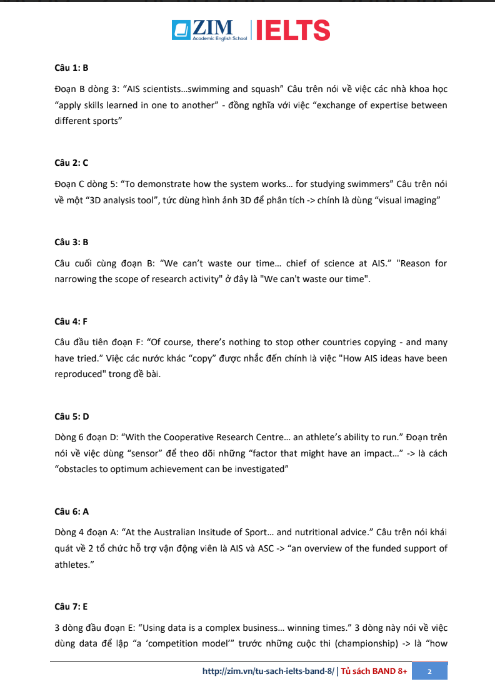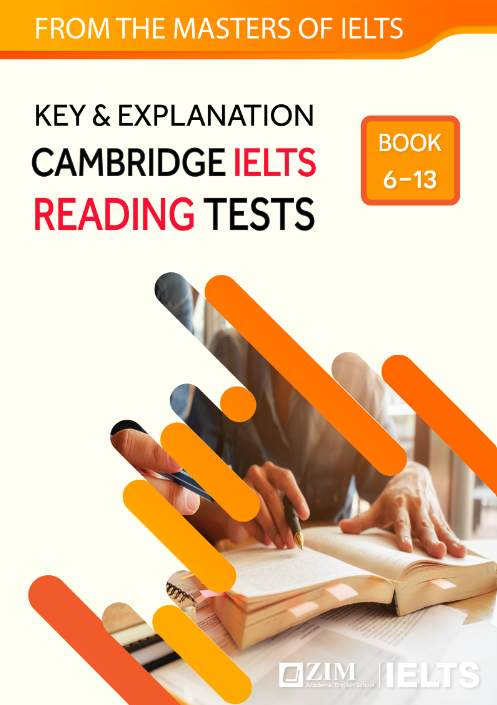


READING TEST 1
Câu 1: B
Đoạn B dòng 3: “AIS scientists…swimming and squash”
Câu trên nói về việc các nhà khoa học “apply skills learned in one to another” – đồng nghĩa với việc “exchange of expertise between different sports”.
Câu 2: C
Đoạn C dòng 5: “To demonstrate how the system works… for studying swimmers”
Câu trên nói về một “3D analysis tool”, tức dùng hình ảnh 3D để phân tích → chính là dùng “visual imaging”.
Câu 3: B
Câu cuối cùng đoạn B: “We can’t waste our time… chief of science at AIS.”
“Reason for narrowing the scope of research activity” ở đây là “We can’t waste our time”.
Câu 4: F
Câu đầu tiên đoạn F: “Of course, there’s nothing to stop other countries copying – and many have tried.”
Việc các nước khác “copy” được nhắc đến chính là việc “How AIS ideas have been reproduced” trong đề bài.
Câu 5: D
Dòng 6 đoạn D: “With the Cooperative Research Centre… an athlete’s ability to run.”
Đoạn trên nói về việc dùng “sensor” để theo dõi những “factor that might have an impact…” → cách “obstacles to optimum achievement can be investigated”.
Câu 6: A
Dòng 4 đoạn A: “At the Australian Institute of Sport… and nutritional advice.”
Câu trên nói khái quát về 2 tổ chức hỗ trợ vận động viên là AIS và ASC → “an overview of the funded support of athletes.”
Câu 7: E
3 dòng đầu đoạn E: “Using data is a complex business… winning times.”
Nói về việc dùng data để lập “a ‘competition model’” trước những cuộc thi → “how performance requirements are calculated before an event”.
Câu 8: A
Dòng cuối cùng trang 18: “It collects images from digital cameras.”
Đoạn C nói về Australia và thì câu văn là present simple → hiện tại Australia đang sử dụng. Không có chỗ nào nói các nước khác cũng đang dùng → exclusive to Australia.
Câu 9: B
Dòng 6 đoạn D: “They are developing unobstrusive sensors.”
Đoạn D vẫn nói về Australia, và “are developing” → mới đang phát triển → sẽ được dùng trong tương lai.
Câu 10: A
Dòng 11 đoạn D: “After years of experimentation… in athletes’ saliva.”
“a test that measures how much of the immune-system protein” → “protein test”.
“developed” → đã phát triển rồi → đang được Australia dùng → exclusive.
Câu 11: C
Dòng 4 đoạn F: “Now everyone uses them. The same has happened to the ‘altitude tent’.”
Nói về phát minh của Australia mà các nước khác đã “copy”, và “the same” = “everyone uses them” → cả Australia và “their rivals”.
Câu 12: (a) competition model
Dòng 2 đoạn E: nói về việc tạo “competition model” để vận động viên có thể lên kế hoạch.
Câu 13: 2%
Dòng 3 đoạn F: “At the Atlanta Olympic Games in 1996, these sliced as much as two per cent off cyclists’ and rowers’ times.”
Vậy cyclists’ performance tăng 2%.
Câu 14: I
Câu cuối đoạn I: “Bringing these barriers down would… even closer.”
Một “suggestion” để “improve trade”.
Câu 15: F
Dòng 2 đoạn F: “Computer software can be… simply by transmitting it over telephone lines from one country to another.”
“Electronic delivery” = transmitting over telephone lines.
Câu 16: E
Dòng 3 từ dưới lên đoạn E: ví dụ về vận chuyển từ Singapore đến Japan/Texas có chi phí tương tự → “will not face hugely bigger freight bills”.
Câu 17: D
Câu cuối đoạn D: “As a result, less transportation is required for every dollar’s worth of imports or exports.”
→ weakening relationship between value of goods and cost of delivery.
Câu 18: True
International trade tăng gấp đôi global economy → đúng.
Câu 19: False
Đoạn B: “Cheap labour may… lose its advantages.”
→ cheap labour không đảm bảo trade hiệu quả.
Câu 20: Not Given
Không so sánh Nhật và Pháp về nhập khẩu.
Câu 21: True
Đoạn D: “Countries still trade disproportionately with their geographic neighbours.”
Câu 22: Not Given
Không nói Germany sản xuất linh kiện máy tính nhỏ.
Câu 23: G – trade
Đoạn G nói modern cargo-handling thúc đẩy trade.
Câu 24: B – components
Disk drives là components.
Câu 25: C – container ships
Container ships khiến vận chuyển hiệu quả.
Câu 26: A – tariffs
Đoạn I nói cần giảm cost of shipping → tương đương tariffs.
Câu 27: i
Người Inuit phản ứng với climate change bằng cách kết hợp knowledge.
Câu 28: vi
Đầu đoạn C nói về sự khắc nghiệt của Canadian Arctic.
Câu 29: iii
Đoạn D nói về alternative sources of essential supplies.
Câu 30: vii
Đoạn E nói về negative effects on well-being (obesity, heart disease, depression).
Câu 40: imported
Đoạn D: imported meat rất đắt → imported produce expensive.
READING TEST 2
Câu 1: ii
Portland: people power thành công → đổi sang light rail.
Câu 2: vii
Đoạn B: tắc nghẽn → travelling time increases.
Câu 3: iv
European cities + Tokyo, Singapore: higher income ≠ more cars.
Câu 4: i
Đoạn D: tránh overcrowded centre → xây village clusters.
Câu 5: iii
Đoạn E: benefits of working together in cities.
Câu 6: False
ISTP chỉ so sánh 37 cities, không phải every city.
Câu 7: True
Efficient cities → better place to live.
Câu 8: Not Given
Không nói tram gây nguy hiểm cho car drivers.
Câu 9: False
Nhu cầu ở inner suburbs tăng → không phải outer.
Câu 10: True
Amsterdam, Copenhagen: high bicycle use → efficient.
Câu 11: F
Perth inefficient due to limited public transport.
Câu 12: D
Auckland hilly → unsuitable for rail.
Câu 13: C
Portland profitably moved from road to light rail.
Câu 14: B – falling
Age-related diseases decreasing.
Câu 15: I – increasing
Rate of decline accelerating.
Câu 16: F – later
Diseases strike later in life.
Câu 17: M – medicine
Câu 18: J – nutrition
Medical advances + improved childhood nutrition.
Câu 19: N – pollution
Rises due to smoking + worse pollution.
Câu 20: K – education
Higher education → live longer.
Câu 21: G – disabled
Disabled elderly decreasing.
Câu 22: A – cost
US saved $200 billion due to fewer disabled elderly.
Câu 23: G
Home medical aids help elderly be more independent.
Câu 24: E
Daily physical activity helps mental functioning.
Câu 25: H
Feeling in control reduces stress in difficult situations.
Câu 26: C
Loneliness → higher stress hormones.
Câu 27: B
Farming created need for numbering system.
Câu 28: E
Extra hand signal used when number words limited.
Câu 29: A
Needed counting ability (to nine) to fulfil civic role.
Câu 30: C
Numbers separated from objects → arithmetic.
Câu 31: G
Expressing numbers differently based on class of items.
Câu 32: True
“Is it enough?” more important than “How many?”
Câu 33: False
Tasmanians only had “one, two, many” → 3 terms, không phải 4.
Câu 34: True
Body language (gestures) prevents confusion.
Câu 35: False
Some cultures cannot deal with large numbers.



